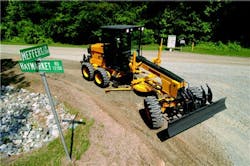Rural City Goes Compact with Grader
For municipal road maintenance crews, there are few options in choosing machinery to maintain unsurfaced roads and a grader is a must-have machine. Traditionally, they are used for routine surface smoothing, removing shoulder berms, removing washboarding, spreading new gravel, ditching and back sloping. However, rural counties that face little growth in funds for their road departments need to be innovative as they juggle costs to maintain their roads.
So when Rick Young, general service superintendent for the City of Dover, Ohio, set out to replace a Galion A-600 Grader, he weighed his options carefully.
“We were looking for something smaller to replace the one we had,” he says. That is why he chose a C86 C from Champion Motor Graders. The C86 C compact articulated all wheel drive grader weighs only 15,500 lbs. and is smaller than a full-sized machine. Size played an important factor in his decision since his department is responsible for maintaining alleys and gravel roads in the region.
“We need to get into 12 foot wide alleys and with the other grader it was really tight sometimes,” says Young, adding that the optional all wheel drive feature will help. “It’s smaller and lighter but we needed all the traction that we can get to go uphill in the winter. It gives us more power to get into an alley and keep it straight because there is not a lot of room in there and we don’t want the machine sliding sideways,” he explains.
Before choosing the C86 C, Young says he did his homework to make sure it could deliver the power and performance that it required by visiting other municipalities to see what they were using.
“We looked at another model from a different outfit, but the Champion machine looked a lot sturdier," Young says. "I like that the frame was made from welded steel and not stamped parts. It’s made like a big grader but it’s smaller. The other machines we looked at didn’t seem to have the strength of the Champion and that was important because it won’t be just me operating it.”
In addition to the standard 10 foot blade, Young also opted for a front dozer blade scarifier, an attachment that is unique to Champion, and air conditioning in the enclosed cab pointing out that once inside it doesn’t feel a whole lot different from a full-sized grader.
“It feels roomy enough inside the cab, just like a regular grader," he says. "The glass goes right down to the floor so we can see the blade. The visibility in the cab is really nice,” he says adding that the adjustable steering wheel and controls contribute to the operator’s comfort.
Getting to and from the jobsite is also much easier with the Champion C86 C, not only because it is small enough to easily load onto a trailer, but because it is small enough to maneuver on roadways, helped along by the hydrostatic power providing variable control through the entire range of ground speeds. “In grading mode, it’s in low-gear but in town we drive it to the jobsite instead of loading it on a trailer. We only have an average of three to four miles to sites and the road-gear gets us up to 20 miles per hour,” he says.
-Source: Champion Motor Graders


